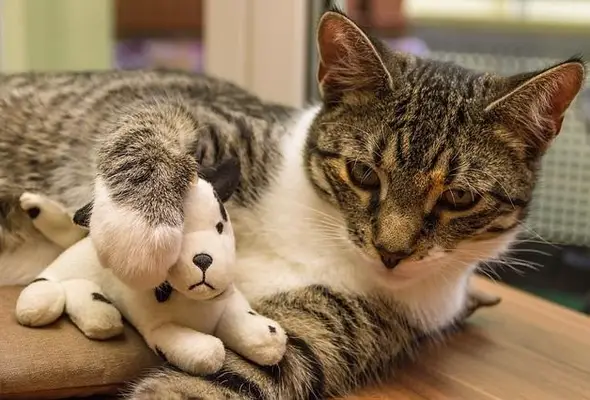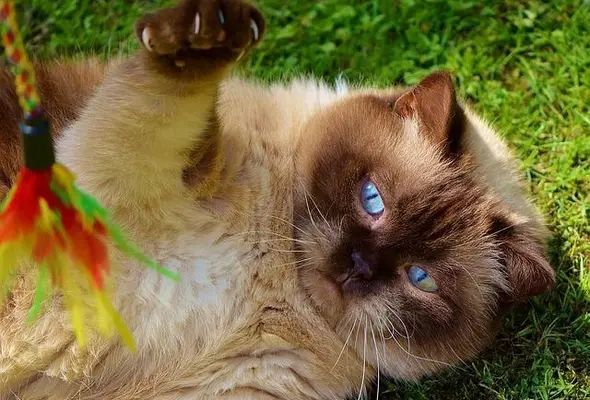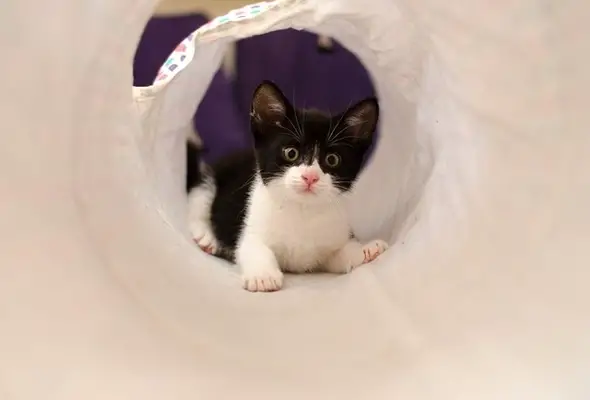Cats are wonderful pets to own, but sometimes they can exhibit concerning or unwanted behavior. Animals, in general, are known to self-soothe in situations where they do not feel completely comfortable, and cats are no exception to this rule.
We have compiled a list of helpful tips on how to get a cat to stop nursing on blankets and instead find more appropriate self-soothing methods.
How to Get a Cat to Stop Nursing on Blankets
While we understand that a cat who nurses on blankets can be frustrating, we would like you to keep in mind that cats who nurse on blankets are exhibiting behavior that can help to soothe them when they are feeling stressed, upset, or feel insecure about themselves or others.
Instead of removing self-soothing from the equation completely, we urge you to offer your cat different self-soothing options that you find more appropriate than nursing on blankets. We will explore a wide variety of activities, environments, and tools that you can use to help your cat self-soothe and destress.
1. Veterinary Exam
You always want to ensure that your cat is healthy when exhibiting unwanted or concerning behaviors.
While the act of a cat nursing on a blanket generally means that they are soothing themselves, this could also indicate some underlying medical concerns that a licensed veterinarian will be able to address and treat.
Cats are prone to developing stress and anxiety, especially if they have been separated from their mother too early or experienced something traumatizing as young kittens.
There is a wide range of treatments for feline anxiety, from play therapy to medication that helps to reduce anxiousness. A veterinarian will be able to guide you through any of these treatment methods.
2. Comforting Environment
Ensuring that your cat feels safe and comfortable in their environment is a great way to reduce stress-induced soothing behaviors like nursing on blankets. If your cat feels confident in their kingdom, they may not need to self-soothe as often.
You can easily spruce up any space to be cat-friendly by adding a cat tree, shelves for perching, investing in a variety of play or toy activities, and having multiple areas for your cat to relax in!
Loads of cats enjoy sunbathing and watching the neighborhood birds and squirrels out of windows, so if your cat enjoys this activity you can find cat beds and perches that attach to windows or window sills for cat relaxation at any pet supply store, or online.
3. Remove Access to Blankets
If your cat will not stop nursing on your blankets, we recommend removing your cat’s access to the blankets you want to preserve. You can purchase cheap, thin blankets from any store and give that to your cat instead. It is important that you do not cut all access to your cat’s self-soothing method.
As we mentioned before, cats will self-soothe to deal with their feelings and emotions, and if you remove their ability to perform that activity, you can actually traumatize your cat and set off a barrage of behavioral issues.
4. Provide an Alternative
As we mentioned previously, you need to provide your cat with something that they are able to self-soothe with to avoid the development of unwanted behavioral issues.

If your cat enjoys nursing to self-soothe, you can invest in a few toys that are marketed for babies! Toys like teething blankets and stuffed animals are wonderful products that let your cat nurse without ruining your blankets.
Creating an easily accessible basket of toys and blankets that are specifically for your cat is a simple way to allow your cat to still have authority over the things they self-soothe without needing to nurse on an unwanted object.
5. Play Time
Playtime is a vital component of maintaining your cat’s overall health, but also their mental well-being. If cats have too much pent-up energy with no outlet to expel, they may begin to get stressed.

Stress can turn into anxiousness which then turns to the need for self-soothing behaviors. We recommend having a dedicated playtime schedule, and if you have multiple cats, they should each get individual play times.
You can play with your cat in the mornings and then again in the afternoon. If you are able to incorporate more play times throughout your daily schedule, this is even better.
Switching your cat’s toys out every so often encourages them to stay engaged in play, and appeals to their inquisitive nature.
6. Feline Enrichment
Just as playtime is important to a cat’s mental well-being, feline enrichment is vital in maintaining a happy and stress-free cat that does not feel the need to nurse on blankets.

Enrichment for cats is easily attainable, you can hide their favorite treats in random spots throughout the areas they have access to, which allows them to get the feeling that they are hunting for prey as they did in the wild.
Cat-friendly treat concealment puzzles are widely available and encourage cats to use their brains and bodies to find hidden treats. Crinkle toys are fairly affordable and serve as a fantastic enrichment option due to their unique texture and sound.
We recommend switching up the enrichment methods that you use to avoid your cat growing bored of the activities. You can even find Cat Grass available at any pet store, which is a small patch of grass you can grow that is safe for cats to eat!
We urge you to be careful and verify that the plant you purchase is from the pet store, as there are countless types of houseplants that are toxic to cats.
7. Soothing Scents
There are certain scents that seem to have a calming effect on felines. You can invest in a diffuser and essential oils that have been formulated for cats. Jackson Galaxy has created multiple soothing essential oils that are available for purchase on Chewy!
Lavender, frankincense, rose, and neroli essential oils can also be diffused in the area your cat frequents, and promotes relaxation and stress relief.
Feliway is a spray that has been formulated specifically for stress relief in cats, can be purchased at most pet stores, and is widely recommended by veterinarians across the US.
8. Cat Only Area
Creating an area specifically for your cat to relax in is a great way to encourage them to stop nursing on blankets.
This space doesn’t have to be anything fancy, you can find a closed-in box (it can be cardboard!), and create a small opening in one of the sides of the box that is just big enough for your cat to fit through.
Baskets are a great option, as well as cat trees or shelves that allow your pet to, as previously mentioned, perch and observe its surroundings. If you choose to go the box route, we recommend placing it in a more secluded and quiet area.
You can fill the box with a comfy bed and a nursing-approved blanket. Sometimes, a cat will find comfort in its owner’s scent, so we recommend placing an old tee shirt in there as well.
Cats are typically very independent and appreciate alone time, so having a safe and comforting area to relax in can help reduce any stress or anxiety your cat may be feeling.
9. Comfort Stuffed Animal
Providing your cat with a stuffed animal can be a great way to negate them from nursing on blankets. You can find a stuffed animal easily, and it does not have to be anything specific.
Pets will occasionally form strong bonds with stuffed animals they are given, and will rely on it for comfort and self-soothing. You can find stuffed animals that are marketed for cats at a variety of pet stores.
We recommend finding a soft stuffed animal that mimics warmth, a heartbeat, and purring which reminds your cat of the memories of comfort that they had with their mother.
Conclusion
We hope you found the tips and tricks we compiled about how to get a cat to stop nursing on blankets.
Keep in mind that completely removing your cats access to self-soothing items can be traumatizing and may result in unwanted behavioral issues. Self-soothing is your cat’s version of self care, and is vital to ensuring a long, healthy, and happy life for your feline friend.

